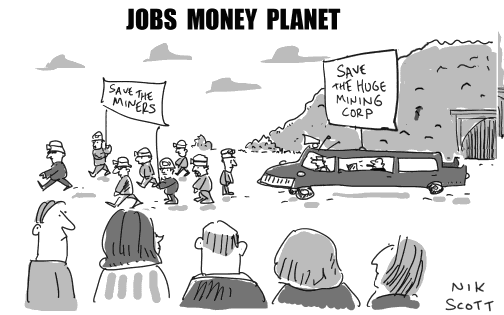Search
Recent comments
- google bias...
54 min 11 sec ago - other games....
57 min 24 sec ago - נקמה (revenge)....
1 hour 57 min ago - "the west won!"....
4 hours 40 sec ago - wagenknecht......
4 hours 41 min ago - the game of war....
7 hours 5 min ago - three packages....
8 hours 25 min ago - russian oil.....
8 hours 33 min ago - crime against peace....
16 hours 44 min ago - why is Germany supporting the ukrainian nazis?....
17 hours 57 min ago
Democracy Links
Member's Off-site Blogs
barracking .....

‘Canadian-owned Barrick Gold, the world's largest gold producer, is exploring, building and operating huge, open-pit gold mines on nearly every continent on the planet.
On average, gold mining today produces 70 tons of waste for every ounce of gold, while also consuming and polluting massive amounts of water. An estimated 50 percent of these mining operations occur on native lands.’
Barrick's Dirty Secrets: Communities Respond To Gold Mining's Impacts Worldwide
from the report …..
Australia’s Lake Cowal, “the Sacred Heartland of the Wiradjuri Aboriginal Nation,” is the largest inland lake in New South Wales (NSW). A wetland of national and international significance, the lake also provides habitat for many threatened species and birds listed under the International Convention on Wetlands (the Ramsar Convention).
For seven years, a community campaign has focused public attention on the cultural and ecological significance of Lake Cowal. Australian organizations supporting the campaign include the Mooka and Kalara Traditional Owners within the Wiradjuri Nation; the Rainforest Information Center; the Indigenous Justice Advocacy Network; the New South Wales Greens Party; Friends of the Earth Australia; Peacebus’ Cyanide Watch; and the Coalition to Protect Lake Cowal, an alliance of more than 21 Australian and 40 international groups.
Lake Cowal is included in Australia’s Directory of Important Wetlands and listed in the Register of the National Estate.
The Cowal Gold Project covers approximately 26.5 square kilometers of this environmentally fragile region. In 1996, the New South Wales government refused an application from North (WA) Ltd. to mine gold at Lake Cowal on environmental grounds. But in February 1999, despite continuing environmentalists’ concerns, a month before a state election and after a second commission of inquiry, the government approved the mine Rio Tinto bought.
Barrick Gold, which operates nine mines in Australia, has been accused of environmentally unsound practices, mining-related accidents and safety violations.
For example, in January 2003, a 26-year old woman was killed in a pitwall collapse at a Barrick mine in Western Australia.
More recently a man driving a truck to the Lake Cowal mine, to collect used muriatic cid, hit a tree at Bumbaldry, NSW. Workers for Barrick sub-contractors have also complained of poor employment conditions.
The mine’s continuing use of enormous amounts of groundwater and now the Lachlan River affects local communities and water sources already enduring the worst drought in New South Wales’ recorded history. Barrick’s bore water licences allow it to take up to 17 million liters per day from underground sources and up to 3650 million liters in any one year.
A 30-metre groundwater level drop in October 2006 had up to 80 landholders anxiously watching their livestock and domestic supplies. In late 2006 Barrick cut a deal with local irrigators to use water from the Lachlan instead of bore water.43 Barrick is building an onsite dam, but it will be useless unless signi.cant rain falls.
On April 19, Australia’s Prime Minister announced that Murray-Darling irrigators faced a water shut-off unless it rained within the next two months.44 Barrick and the government will not reveal how much water the company is taking from ground and surface water sources combined and whether its deal with irrigators will continue.
At Lake Cowal, Barrick processes very low-grade ore with minimal residues of gold. Leaching gold from the ore requires 6,613 tons [6,000 metric tons] per year of cyanide and other hazardous chemicals.45 The copious waste from this process goes into open pits separated from the lake by an earthen wall or “bund.” The mine tailings are stored within the floodplain in unlined dams 3.5 kilometers from the lake.
The two tailings ponds, containing highly toxic chemicals, are a tempting habitat for migratory birds.
Another danger comes from transporting the poisonous cyanide.
Up to 6,090 metric tons of the chemical travels 1600 kilometers to Lake Cowal every year from Orica’s plant in Gladstone, Queensland.
Trains and trucks carry the cyanide to Lake Cowal over 20 rivers, through ten national parks, and past 200 towns that the route traverses A 2004 Western Australian government’s report on the Kalgoorlie Super Pit, a Barrick-Newmont joint venture, found a large area around the Fimiston 1 tailings dam was affected by cyanide and heavy metal contamination, elevated groundwater cyanide levels, and increased salinity.
Kalgoorlie Consolidated Gold Mines (KCGM) admitted on July 27, 2005, that the mine’s roaster and carbon kilns were emitting seven metric tons of mercury per year.
- By John Richardson at 3 May 2007 - 11:00pm
- John Richardson's blog
- Login or register to post comments
soooo sorry .....
‘Protest Barrick, a network of aboriginal communities from Australia, the U.S., Latin America and Asia, converged on Barrick Gold Corporation's shareholder meeting at the Metro Toronto Convention Centre May 2 to serve the company an eviction notice from First Nation land.
As shareholders entered the meeting, representatives of Nevada's Shoshone Nation and Australia's Wiradjuri handed them leaflets alleging water depletion and contamination from cyanide, a chemical used to extract gold from crushed ore.
Some demonstrators held proxy ballots and were able to enter the AGM to personally tell shareholders and chair Peter Munk what their communities are facing.
"I approached Munk after the meeting to tell him how Barrick is desecrating our sacred site, our dreaming place [Lake Cowal],'' says Neville "Chappy" Williams, an elder of the Wiradjuri from New South Wales.
The answer from Munk, he says, was: "I'm so sorry.''
Barrick Boss Gets Served